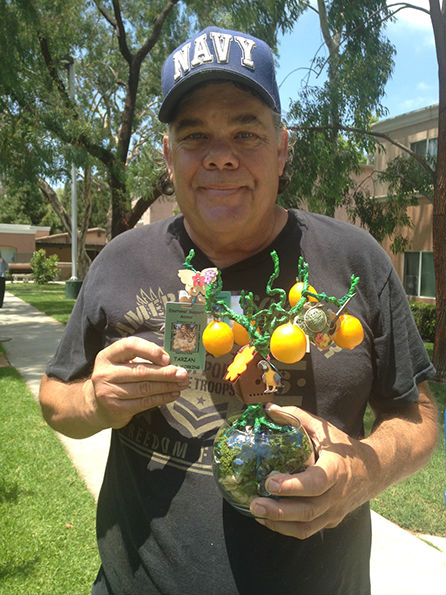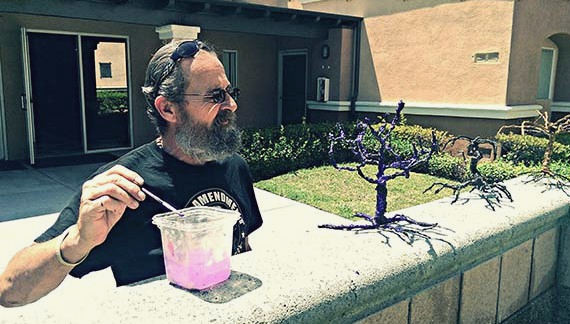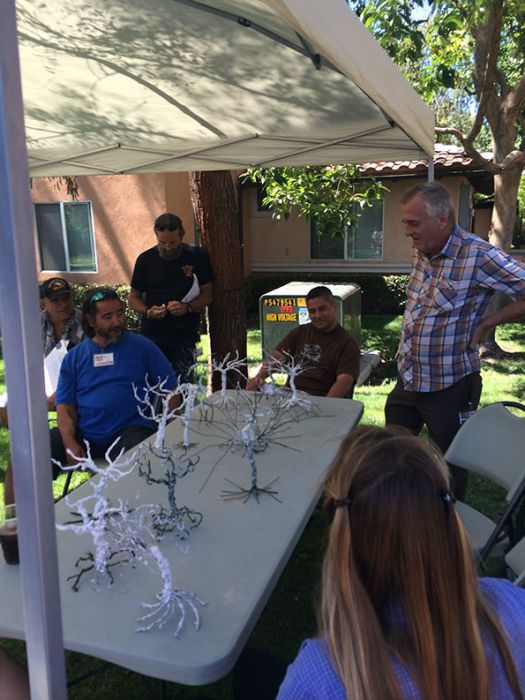
Eric, a U.S. military veteran, hangs his cat’s rescue animal tag on his miniature, three-dimensional tree along with several oranges.
The items may seem a bit random, but they are significant to Eric. His cat is his best friend and provides him much-needed emotional support, while the oranges remind him of his childhood and family home that had an orange tree in the yard.
Made of floral wire and plaster, Eric constructed his art piece as part of the “Vision Tree,” an art therapy project designed by California State University, Dominguez Hills (CSUDH) alumnus Teddy Um (Class of ’14, M.A., occupational therapy). The six-week project has successfully helped improve coping skills for U.S. military veterans in recovery from combat trauma, substance addiction and homelessness at the 27-acre Century Villages at Cabrillo (CVC) Transitional Housing Shelter Community in Long Beach.
“I thought creating something artistically meaningful would have a powerful effect on motivation and self-awarness,” said Um, a Westminster resident. “Art becomes an embodiment and manifestation of one’s goals that induces positive self-transformation. So I wanted to create an art project that would be artistic and meaningful, and I thought making a tree would be a great idea because a tree represents life.”
Um designed the art therapy project while still a student at CSUDH as a part of his fieldwork rotation with the Pan-American Mokichi Okada Association (MOA) Foundation. He administered it with the help of current CSUDH occupational therapy graduate students Cassandra Hudson, Jessica Lam, Leilua Satele, Vanessa Ladson, Monika Vartanyan, Laura Leppke, Laura Perez and Jessica Oberinger. Um also worked in collaboration with his fieldwork supervisor Susan Brislin, an occupational therapist at the CVC whose work provided him the inspiration for the Vision Tree project.

Um said he designed the Vision Tree project to help veterans develop goals, interests, and recovery strategies as they transition from being homeless. Through the project, participants construct the trees and then design or find ornaments to hang on the trees’ branches that represent things from their lives and specific goals.
The Vision Tree project also included for the veterans guided meditation, customized music with songs that represented important life stages and relationships, as well as group discussion and journaling as part of their art therapy group.
“We played songs that represented significant people and moments that were shared by the veterans during ‘Ice Breaker’ sessions,” said Um. “At the end of each session, the group gathered around the garden to share something about their trees and the connections they made to their lives.”
The sessions helped create “spiritual and healing therapy” for the veterans, according to Um.
“Looking at all the bends and twists in this tree, I’m reminded of my life,” shared one veteran. “Trees go through a lot changes and they’re still standing. I’ve been through tough times in my life, too, and I’m still standing.”

An occupational assessment was administered to each participant before and after the treatment program to address the veterans’ performance and satisfaction levels.
“It was extremely rewarding to watch the veterans show up each week so excited to work on their trees. During the sessions, it amazed me how engaged they were,” said Um. “Their trees were not only unique and beautiful, but each had a veteran’s personal story behind it. It was extremely powerful.”
At the end of the six weeks, the Vision Tree project enabled the veterans to open up more and demonstrate leadership and community building skills. Some veterans began leading projects at the CVC, such as teaching others how to make pottery, while others began getting back into old hobbies. One looked forward to re-engaging with his friends and family.
“My daughter’s name is Ashley, so I made an Ash tree,” said a veteran. “Working on the tree reminded me of her. Now that I’m sober, I can help her. I can help her grow like this tree.”